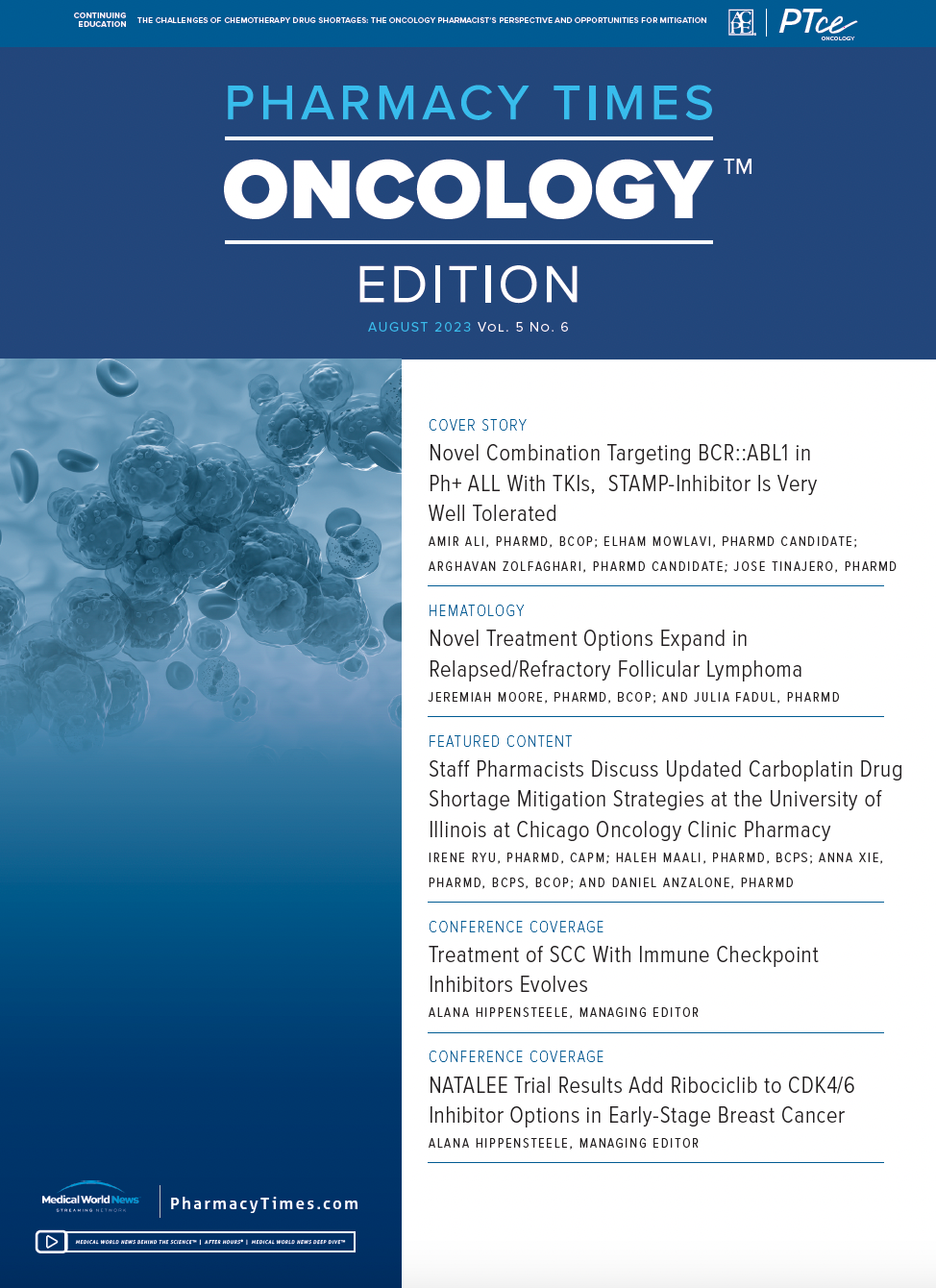Publication
Article
Pharmacy Practice in Focus: Oncology
Advocacy, Education of Individuals With Myeloproliferative Neoplasms Are Important to Support Patient Engagement, Outcomes
Author(s):
Pharmacists also have the resources to help advocate for better care for patients.
Patients with hematologic myeloproliferative neoplasms (MPNs)—a group of rare blood diseases that include primary myelofibrosis, essential thrombocythemia (ET), and polycythemia vera (PV)—should be more active in their treatment plan, according to experts in oncology pharmacy who participated in a Pharmacy Times clinical forum in Chicago, Illinois, in June 2023. “Our role as pharmacists is to give [patients] as much information as we possibly can, then encourage them to move forward with advocating for themselves,” said Krystal Preston, PharmD, BCPS, a senior clinical oncology pharmacist at CVS Health and a clinical pharmacist at the University of Chicago Medicine.
Credit: MdBabul - stock.adobe.com

Patients who are serious about taking an active role in their treatment could inspire health care providers to collaborate more, both with them and with other members of the care team, according to discussion leader Zahra Mahmoudjafari, PharmD, MBA, BCOP, FHOPA, clinical pharmacy manager of hematology, blood and marrow transplant, and cellular therapy at the University of Kansas Health System in Mission.
Subtypes of MPNs, ET, and PV typically transform into myelofibrosis, which can subsequently turn into acute myelocytic leukemia (AML). At least 20% of MPNs may transform into AML; therefore, the goal for treatment is to prevent this from occurring, Mahmoudjafari explained.
With more than 90% of patients with PV having a JAK2 mutation, “it is probably, by far, the mutation that we have the most actionable ability to do something about,” Mahmoudjafari said. She noted that there are 3 FDA-approved Janus kinase (JAK) inhibitors for MPN—ruxolitinib (Jakafi; Incyte), fedratinib (Inrebic; Bristol Myers Squibb), and pacritinib (Vonjo; CTI BioPharma Corp)—which were approved based on results from the COMFORT-I (NCT00952289), JAKARTA (NCT01437787), and PERSIST-2 (NCT02055781) pivotal trials, respectively.
Ruxolitinib and fedratinib are primarily for patients with intermediate- or high-risk myelofibrosis, including intermediate-2 risk and primary and post-PV/ ET myelofibrosis, Mahmoudjafari explained. Pacritinib is indicated for patients with a platelet count below 50,000; all 3 JAK inhibitors have expected adverse event (AE) profiles, which include thrombocytopenia, anemia, bruising, dizziness, headache, and diarrhea.
Although the only true potentially curative treatment for myelofibrosis is transplant, there is a 30% mortality risk associated with it, Mahmoudjafari said. Further, patient adherence remains a predominant issue in patient care, according to Connor Roth, PharmD, BCOP, hematology/oncology pharmacy specialist with Franciscan Alliance, Inc in Chicago, Illinois. Whether due to dosing schedule, toxicities, cost, or all these reasons, people remain forgetful, Roth said. It is much harder to contact patients with a reminder via phone call because “nobody picks up [a call from] a phone number they don’t know,” Roth added.
Tammy McClellan, PharmD, a clinical oncology pharmacist at Riverside Healthcare in Kankakee, Illinois, said one of the greatest unmet needs she is seeing is timely access to medications. The faster a patient can get on a proper treatment regimen, the better they can prevent a blood-clotting event.
Insurance is another barrier to access; however, pharmacists understand how to work within the system and are best positioned to advocate for patients, according to Roth. Location is equally important for access to medications because patients living close to a city can access treatment centers and pharmacies more easily than those in a rural setting. Patients in cities also have better access to clinical trials, Preston said.
McClellan noted that an unmet patient need is effective communication with care providers. She said patients frequently mention that their provider does not listen to their input often enough.
McClellan said a solution may be individualized patient care. Further, Latha Radhakrishnan, PharmD, BCOP, BCPS, a clinical oncology pharmacist and an assistant professor in the College of Pharmacy at the University of Illinois at Chicago, noted that pharmacists and providers can foster improved individualized care through better organized collaboration with the patient and care team. This can make it easier to manage AEs and drug-drug interactions because treatment can be exceedingly difficult, according to Mahmoudjafari. Therefore, improving AE management can improve patient quality of life. “[Symptoms can be] enough to drive these patients absolutely insane,” McClellan added.
Additionally, financial burden is a significant issue for many patients. For this reason, some clinics have financial navigators who work with pharmacists and patients to coordinate benefits, co-pays, and prior authorization. Other institutions may assign these tasks to specialty pharmacists, who typically have experience with patient assistance programs that help older adults or individuals with limited resources to access affordable medications via grants, foundational support, or other means. Ideally, insurance or patient assistance would be connected to the patient’s electronic medical record, according to Roth. The panelists also emphasized patient education. “I really try to explain to [patients], in layman’s terms, what’s going on and just listen to what their issues are,” Preston said.
The panelists said that a best practice is to provide as much information about the disease state and treatment as possible. Because many patients do not understand their disease state, improving their understanding can provide the patient with more control, which can lead them to feeling better able to express concerns and be their own advocate.
“You can’t make the assumption that the patient already knows [everything],” Mahmoudjafari said. This is especially important because oncologists or other providers may be struggling to keep up with a complicated, changing treatment and guidelines landscape.
“Guidelines are dividing, and there’s so many things to know [about the drugs],” Roth said. “Pharmacists can be the ones to extend the hands of the physicians and be a patient advocate when [the patient] doesn’t always have one.”
Reference
American Society for Clinical Oncology. Pharmacy Times Clinical forum. 2023 American Society of Clinical Oncology Annual Meeting; June 2-6, 2023; Chicago, IL. Accessed July 13, 2023. https://conferences.asco.org/am/attend

Newsletter
Stay informed on drug updates, treatment guidelines, and pharmacy practice trends—subscribe to Pharmacy Times for weekly clinical insights.






